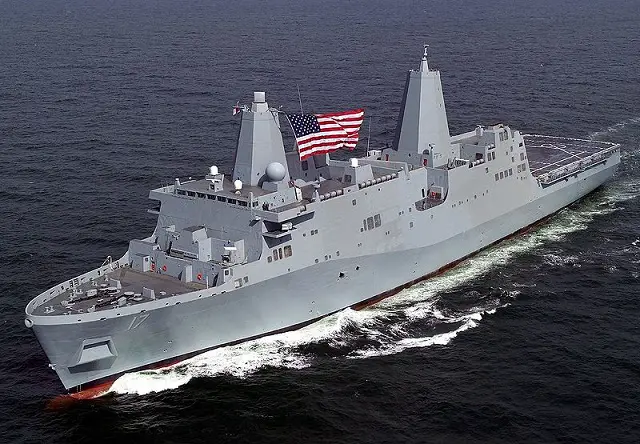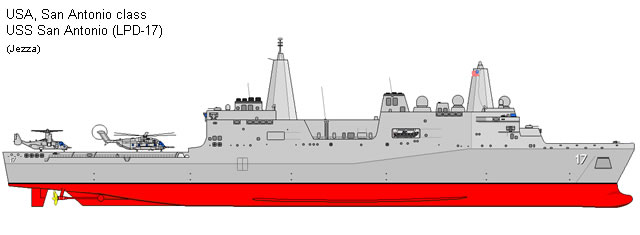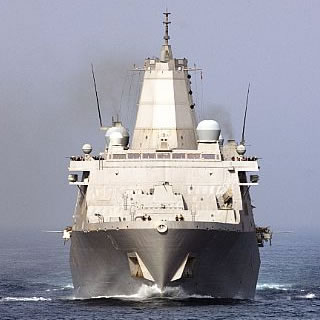San Antonio class
| a | ||||||||||||||||||||||||||||||||||||||||||||||||||||||||||||
|
San Antonio Class (LPD 17) Amphibious Transport Dock
also known as Landing Platform Dock / Amphibious Assault Ship |
||||||||||||||||||||||||||||||||||||||||||||||||||||||||||||
 |
||||||||||||||||||||||||||||||||||||||||||||||||||||||||||||
|
|
||||||||||||||||||||||||||||||||||||||||||||||||||||||||||||
|
As the San Antonio-class LPDs have entered service in recent years, Austin-class LPDs have been decommissioned. Collectively, these ships functionally replace over 41 ships (LPD 4, LSD 36, LKA 113, and LST 1179 classes of amphibious ships) providing the Navy and Marine Corps with modern, seabased platforms that are networked, survivable, and built to operate with 21st century transformational platforms, such as the MV-22 Osprey, the Expeditionary Fighting Vehicle (EFV), and future means by which Marines are delivered ashore. |
||||||||||||||||||||||||||||||||||||||||||||||||||||||||||||
| Shiplist | ||||||||||||||||||||||||||||||||||||||||||||||||||||||||||||
|
||||||||||||||||||||||||||||||||||||||||||||||||||||||||||||
|
Variants
|
||||||||||||||||||||||||||||||||||||||||||||||||||||||||||||
|
- HII has a project for an Aegis Ballistic Missile Defense version based on the San Antonio class hull
|
||||||||||||||||||||||||||||||||||||||||||||||||||||||||||||
| Technical Data | ||||||||||||||||||||||||||||||||||||||||||||||||||||||||||||
| Design | ||||||||||||||||||||||||||||||||||||||||||||||||||||||||||||
|
The design of the San Antonio Amphibious Assault Ships was jointly developed by U.S. Navy, Marine Corps and industry stakeholders to provide superior performance over a broad range of operational requirements. Construction of the ships continues at Ingalls' shipyards in Pascagoula Mississippi and Avondale Louisiana.
The unique design-engineering approach injected fleet input into the development process before construction began and shaped every element of the ships' systems and spaces to meet future requirements. Each LPD consists of 210 units built utilizing modular construction techniques. Each unit is extensively pre-outfitted with piping, electrical, machinery and ventilation systems along with many pieces of equipment prior to launch. |
||||||||||||||||||||||||||||||||||||||||||||||||||||||||||||
| Features | ||||||||||||||||||||||||||||||||||||||||||||||||||||||||||||
|
San Antonio class LPDs are used to transport and land Marines, their equipment and supplies by embarked air cushion (LCAC) or conventional landing craft and Expeditionary Fighting Vehicles (EFV) or Amphibious Assault Vehicles (AAV) augmented by helicopters or vertical take off and landing aircraft (MV 22). These ships support amphibious assault, special operations or expeditionary warfare missions and can serve as secondary aviation platforms for amphibious ready groups.
Capacity: » 14 Expeditionary Fighting Vehicles » 2 LCAC landing craft or 1 LCU » Launch or land two CH53E Super Stallion helicopters or two MV-22 Osprey tilt rotor aircraft or up to four CH-46 Sea Knight helicopters, AH-1 or UH-1 helicopters. » Embarked Landing Force: 699 (66 officers, 633 enlisted); surge capacity to 800. |
||||||||||||||||||||||||||||||||||||||||||||||||||||||||||||
| Missions | ||||||||||||||||||||||||||||||||||||||||||||||||||||||||||||
|
The multi-mission LPD 17 class plays a pivotal role in maintaining national security and strengthening the fleet. The ships are modern, networked sea-based platforms that feature improved command and control and enhanced survivability systems combined with tactical lift capability for transporting Marine Expeditionary Units. The Marines and their equipment are landed by embarked landing craft (LCAC) air cushion or conventional landing craft and amphibious assault vehicles, augmented by helicopters or vertical takeoff aircraft like the MV-22 Osprey.
Typical Missions include: » Amphibious assault » Special Operations » Expeditionary Warfare » Humanitarian Relief |
||||||||||||||||||||||||||||||||||||||||||||||||||||||||||||
| Weapons | ||||||||||||||||||||||||||||||||||||||||||||||||||||||||||||
|
||||||||||||||||||||||||||||||||||||||||||||||||||||||||||||
| Sensors, Electronics and Decoys | ||||||||||||||||||||||||||||||||||||||||||||||||||||||||||||
|
||||||||||||||||||||||||||||||||||||||||||||||||||||||||||||
| Power Generation/Propulsion | ||||||||||||||||||||||||||||||||||||||||||||||||||||||||||||
| Four sequentially turbocharged marine Colt-Pielstick Diesels, two shafts, 41,600 shaft horsepower. | ||||||||||||||||||||||||||||||||||||||||||||||||||||||||||||
| Specifications | ||||||||||||||||||||||||||||||||||||||||||||||||||||||||||||
|
||||||||||||||||||||||||||||||||||||||||||||||||||||||||||||
 |
||||||||||||||||||||||||||||||||||||||||||||||||||||||||||||
|
||||||||||||||||||||||||||||||||||||||||||||||||||||||||||||
  |
||||||||||||||||||||||||||||||||||||||||||||||||||||||||||||
|
|
||||||||||||||||||||||||||||||||||||||||||||||||||||||||||||
| {gallery}north_america/usa/amphibious/San_Antonio/pictures{/gallery} | ||||||||||||||||||||||||||||||||||||||||||||||||||||||||||||




























